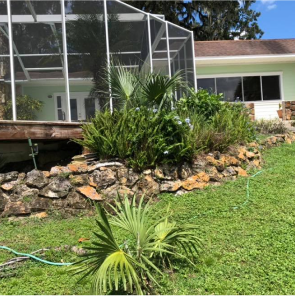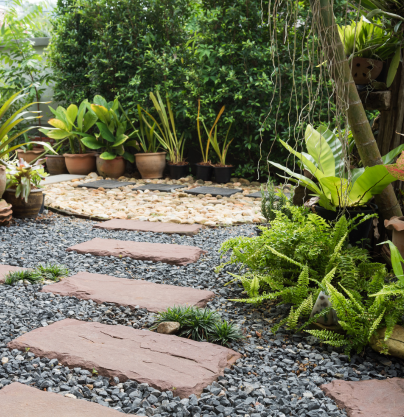Art comes in many forms, and one of the most captivating canvases nature provides is your own yard. Crafting a masterpiece of outdoor aesthetics involves a delicate dance between two key elements: hardscape and softscape. These words may seem alien, but they hold the secret to transforming your outdoor space into a harmonious oasis. Hardscape encompasses the solid structures like patios and walkways, while softscape embraces the living, breathing elements, such as plants and trees. In this exploration, we unravel the intricate art of balancing hardscape and softscape in your yard, unlocking the secrets to a visually stunning and functionally versatile outdoor haven.
What is Hardscape?
In the realm of landscape design, hardscape is the sturdy backbone that gives structure and definition to your outdoor space. To embark on the journey of balancing hardscape and softscape in your yard, it’s crucial to grasp the concept of hardscape and its significance in crafting an appealing and functional outdoor environment.
Hardscape refers to the non-living, man-made elements in your yard. These elements create the foundation upon which the softer, natural elements can flourish. Hardscape encompasses a wide range of features, including:
- Patios and Decks: These provide outdoor living spaces for relaxation, dining, and entertainment. Materials like concrete, stone, pavers, or wood are commonly used to create these surfaces.
- Pathways and Walkways: Hardscaped paths guide visitors through your yard, connecting different areas. They can be made from materials similar to patios or contrasting ones for visual interest.
- Retaining Walls: Often used to manage slopes and elevation changes, retaining walls are both functional and aesthetic. They can be made from various materials, such as stone, concrete blocks, or wood.
- Driveways: While primarily functional, driveways contribute to your yard’s overall design. Materials like concrete, asphalt, or interlocking pavers are common choices.
- Fences and Gates: These hardscape elements define property boundaries, add privacy, and contribute to security. The materials for fencing range from wood and vinyl to metal.
- Outdoor Kitchen and Fireplaces: Perfect for outdoor gatherings, these hardscape features include grills, countertops, and fire pits or fireplaces.
- Water Features: Ponds, fountains, and waterfalls add a dynamic element to your yard. Hardscape components, like the basin and surrounding stonework, form the structure of these features.
The Functionality of Hardscape
Hardscape elements serve both practical and aesthetic purposes:
- Functionality: They create functional spaces for various outdoor activities such as dining, lounging, or recreational games.
- Organization: Hardscape structures define and organize your yard into distinct zones, making it more visually appealing and functional.
- Durability: Hardscape materials are chosen for their ability to withstand the elements and heavy use, ensuring long-term performance and low maintenance.
- Visual Impact: Well-designed hardscape can enhance the overall aesthetics of your yard, providing texture, color, and visual interest.

Defining Softscape
Softscape is the living, breathing soul of your outdoor sanctuary. As we continue our exploration of balancing hardscape and softscape in your yard, it’s time to unravel the enchanting world of softscape and appreciate its vital role in creating a harmonious and vibrant outdoor haven.
Softscape comprises the organic and living elements in your landscape design. These elements add life, color, texture, and vitality to your outdoor space. Key components of softscape include:
- Plants: From flowering perennials to graceful ornamental grasses and majestic trees, plants are the heart and soul of softscape. They introduce a dynamic, ever-changing aspect to your yard.
- Shrubs and Bushes: These versatile plants can serve as natural privacy screens, ground covers, or focal points in your landscape.
- Trees: Majestic trees not only provide shade but also add height and character to your yard. They are essential for a balanced and biodiverse softscape.
- Flower Beds and Borders: These bring bursts of color and seasonal variety to your landscape. Well-placed flower beds can transform your yard into a visual masterpiece.
- Lawns and Ground Covers: Grass and other ground cover plants create lush, inviting areas for recreation and relaxation.
- Hedges and Topiaries: These elements add structure and formality to your yard, defining spaces and pathways.
- Vegetable and Herb Gardens: For those with a green thumb, these gardens offer fresh produce and a touch of nature within arm’s reach.
The Role of Softscape
Softscape elements contribute to your yard’s aesthetics, functionality, and ecological balance:
- Beauty and Aesthetics: Softscape brings life and beauty to your yard, offering an ever-changing palette of colors, scents, and textures throughout the seasons.
- Biodiversity: A well-planned softscape promotes biodiversity by providing habitats for birds, insects, and other wildlife. Native plants, in particular, play a crucial role in supporting local ecosystems.
- Environmental Benefits: Softscape helps mitigate environmental challenges by reducing soil erosion, absorbing rainwater, and mitigating heat island effects.
- Wellness and Relaxation: Green spaces with softscape elements contribute to mental and physical well-being. They provide places for relaxation, meditation, and outdoor activities.
- Versatility: Softscape elements can be strategically positioned to soften the edges of hardscape, creating a seamless blend of the two elements.
The Art of Balance
In the grand tapestry of yard design, achieving the perfect balance between hardscape and softscape is akin to mastering a fine art form. This delicate equilibrium, where the solidity of man-made structures harmonizes with the vibrancy of nature, can transform your outdoor space into a breathtaking masterpiece. As we delve deeper into the world of landscaping, it’s time to explore why this art of balance is so crucial and how it can elevate both the beauty and functionality of your yard.
Why Balance Matters
Balance in yard design is not a mere aesthetic pursuit; it’s a fundamental principle that impacts the usability, appeal, and sustainability of your outdoor space. Here are a few reasons why balance matters:
- Visual Harmony: A well-balanced yard is visually appealing. It creates a sense of order and symmetry that is pleasing to the eye, making your outdoor space inviting and captivating.
- Functionality: Balance ensures that your yard serves its intended purposes. It provides comfortable spaces for relaxation, entertainment, and recreation, while also allowing for the growth and health of your greenery.
- Environmental Considerations: Balance contributes to the ecological health of your yard. When hardscape and softscape are in harmony, it encourages biodiversity, supports local ecosystems, and mitigates environmental issues like soil erosion and flooding.
- Maintenance Ease: A balanced design is practical to maintain. It minimizes issues such as overgrown plants encroaching on pathways or excessive water runoff from impermeable hardscape surfaces.
Challenges in Achieving Balance
Achieving the perfect balance between hardscape and softscape can be challenging due to various factors:
- Space Constraints: Limited space may restrict your options, making it difficult to create a harmonious blend of both elements.
- Budget: Financial constraints can limit your choices, potentially leading to an imbalance in your design.
- Climate: Local weather conditions, such as extreme heat or cold, can affect the type of hardscape and softscape elements you can use.
- Maintenance: Balancing maintenance efforts between hardscape and softscape requires careful planning to ensure both remain in top condition.

Design Principles for Balancing Hardscape and Softscape
Creating a harmonious and balanced yard that seamlessly integrates hardscape and softscape elements requires a thoughtful approach. Several design principles can guide you in achieving this delicate equilibrium:
- Proportion and Scale: Balancing your yard’s hardscape and softscape requires careful proportion and scale, ensuring neither dominates and creating a harmonious visual relationship that complements the other.
- Unity and Harmony: Harmony in outdoor spaces requires cohesive hardscape and softscape elements, following a shared design theme or color palette, fostering a sense of purpose and flow.
- Focal Points and Focal Areas: Balancing hardscape and softscape is essential, with hardscape features like patios and water fountains drawing attention, and softscape areas like gardens anchoring the yard’s design.
- Practicality and Maintenance Considerations: A balanced landscape should balance aesthetics, functionality, and practicality, aligning with lifestyle and maintenance requirements, and choosing materials and plants that match available resources.
Creative Ideas for Balancing Hardscape and Softscape
Get imaginative with your outdoor oasis by seamlessly merging hardscape and softscape elements. Consider a lush garden pathway, where soft, flowering plants frame a meandering stone walkway. Or, transform a boring retaining wall into a vertical garden, letting vines and cascading plants breathe life into the structure. For a cozy retreat, blend a wood deck with strategically placed potted trees and shrubs, providing both shade and privacy.
Embrace the art of container gardening by placing vibrant flowers and herbs in attractive pots along your hardscape features, infusing color and fragrance into your outdoor haven. These creative ideas not only balance form and function but also infuse your yard with personality and charm.
Practical Tips for Implementation
Balancing hardscape and softscape in your yard is a rewarding endeavor that requires careful planning and execution. To bring your outdoor vision to life successfully, consider these practical tips:
- Plan Before You Build: Start with a well-thought-out landscape plan that includes both hardscape and softscape elements. Consider the placement of patios, walkways, and planting areas to achieve balance and flow.
- Consider the Environment: Choose hardscape materials and softscape plants that are well-suited to your local climate and soil conditions. Native plants often require less maintenance and water.
- Work with Existing Features: If you have mature trees, incorporate them into your design rather than removing them. Existing natural elements can add character and provide shade.
- Layer and Texture: Create depth and interest by layering plants of varying heights and textures. Mix hardscape materials for visual appeal, combining stone, wood, and concrete, for instance.
- Prune and Maintain Regularly: Keep both hardscape and softscape well-maintained. Regular pruning, weeding, and cleaning of hardscape surfaces will ensure that your yard stays beautiful and functional over time.
Maintaining the Balance Over Time
Achieving a harmonious balance between hardscape and softscape is an ongoing endeavor. Regularly assess your yard’s condition and make adjustments as needed. Trim overgrown plants, replace damaged hardscape elements, and update your softscape to accommodate growth.
Consider seasonal changes in your maintenance routine and adapt to weather conditions. Periodic inspections and proactive care will help your outdoor masterpiece age gracefully, ensuring that the delicate equilibrium between hardscape and softscape remains intact for years of enjoyment.
Conclusion
In the artful fusion of hardscape and softscape, your yard becomes more than just an outdoor space; it becomes a living masterpiece. Balancing these elements isn’t just about aesthetics; it’s about creating an environment that reflects your unique vision while considering practicality and sustainability. As you embark on this journey, remember that achieving harmony between hardscape and softscape is an ongoing process.